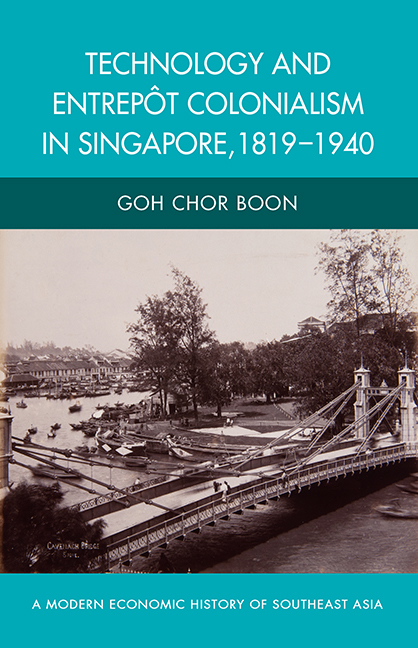Book contents
- Frontmatter
- Contents
- List of Figures and Tables
- Notes on Currency
- Introduction
- 1 Technology and the British Empire
- 2 Pioneers of Change: Entrepreneurs and Engineers
- 3 Maritime Technology and Development of the Port
- 4 Introducing Technological Systems
- 5 Sanitation and Public Health
- 6 Agriculture and Colonial Science
- 7 Food and Singapore Cold Storage
- 8 Politics of Imperial Education
- 9 Technology Transfer and Limited Industrial Growth
- Conclusion
- Bibliography
- Index
2 - Pioneers of Change: Entrepreneurs and Engineers
Published online by Cambridge University Press: 21 October 2015
- Frontmatter
- Contents
- List of Figures and Tables
- Notes on Currency
- Introduction
- 1 Technology and the British Empire
- 2 Pioneers of Change: Entrepreneurs and Engineers
- 3 Maritime Technology and Development of the Port
- 4 Introducing Technological Systems
- 5 Sanitation and Public Health
- 6 Agriculture and Colonial Science
- 7 Food and Singapore Cold Storage
- 8 Politics of Imperial Education
- 9 Technology Transfer and Limited Industrial Growth
- Conclusion
- Bibliography
- Index
Summary
The Industrial Revolution in the West introduced to the world a series of technological changes embodied in the development of railways, steamships, the telegraph, and the mechanized factory. They were made possible mainly by three categories of individuals — inventors, engineers and entrepreneurs. Inventors and engineers created things that have never been created before. Entrepreneurs think of ways of adapting the inventions to the needs of the consumer markets, that is, they turn an invention into an innovation. Thomas Edison, for example, is an inventor — but he was also an entrepreneur because he invented a feasible electric bulb, then designed a system that would deliver electricity to lighting customers, and eventually incorporated a number of companies to manufacture all parts and to supply the electric service. Colonial Singapore did not possess inventors who created products that were developed by entrepreneurs for the mass markets, or structures and projects that were completed by the skills and knowledge of locally trained engineers. It was strictly a busy trading outpost where the engine of commercial growth was driven by thousands of migrants from India, China and the Malay Archipelago, and parts of the British Empire. They were convinced that, with the protection of the British law, there were many pots of gold at the end of the rainbow. This chapter looks into the pioneering roles of nineteenth century individuals in laying the foundation of Singapore's entrepôt economy.
Role of the European Agency House and the Chinese Comprador
Beginning with the arrival in 1819 of Alexander Johnston who started the first European agency house in the following year, a steady stream of European merchants and entrepreneurs soon arrived and established agency houses and business operations, many of which were the forerunners of several big companies in Singapore today. Notable among them were Alexander Guthrie, Edward Boustead, William Paterson, Benjamin Keasberry, Abraham Logan, Robin Woods, and John Cameron. As Singapore's trade grew the number of European firms also increased steadily, from 14 in 1827, to 36 in 1855, and 62 in 1872. The number of residents in the European community, however, remained small and grew slowly, from 74 in 1824, to 360 in 1849, and 466 in 1860.
- Type
- Chapter
- Information
- Publisher: ISEAS–Yusof Ishak InstitutePrint publication year: 2013



